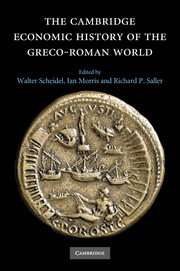Book contents
- Frontmatter
- 1 Introduction
- Part I Determinants of Economic Performance
- Part II Early Mediterranean Economies and the Near East
- Part III Classical Greece
- Part IV The Hellenistic States
- Part V Early Italy and the Roman Republic
- Part VI The Early Roman Empire
- Part VII Regional Development in the Roman Empire
- 24 The Western Provinces
- 25 The Eastern Mediterranean
- 26 Roman Egypt
- 27 The Frontier Zones
- Part VIII Epilogue
- Bibliography
- Index
- Map 1.1 The Mediterranean basin"
- Map 10.1 Greek and Phoenician trade in the period of the Persian Wars"
- Map 11.1 The Achaemenid empire"
- Map 12.1 Greece and Asia Minor"
- Map 15.1 The Seleucid empire"
- Map 16.1 Greco-Roman Egypt"
- Map 20.1 The Roman empire at the accession of Vespasian"
- References
27 - The Frontier Zones
from Part VII - Regional Development in the Roman Empire
Published online by Cambridge University Press: 28 March 2008
- Frontmatter
- 1 Introduction
- Part I Determinants of Economic Performance
- Part II Early Mediterranean Economies and the Near East
- Part III Classical Greece
- Part IV The Hellenistic States
- Part V Early Italy and the Roman Republic
- Part VI The Early Roman Empire
- Part VII Regional Development in the Roman Empire
- 24 The Western Provinces
- 25 The Eastern Mediterranean
- 26 Roman Egypt
- 27 The Frontier Zones
- Part VIII Epilogue
- Bibliography
- Index
- Map 1.1 The Mediterranean basin"
- Map 10.1 Greek and Phoenician trade in the period of the Persian Wars"
- Map 11.1 The Achaemenid empire"
- Map 12.1 Greece and Asia Minor"
- Map 15.1 The Seleucid empire"
- Map 16.1 Greco-Roman Egypt"
- Map 20.1 The Roman empire at the accession of Vespasian"
- References
Summary
What survives to describe the frontier provinces of the Roman empire hints at a significant measure of economic development in some of the frontier zones, and perhaps especially in north Africa, until about the middle of the third century ad. But in the almost complete absence of reliable, quantitative information, it is generally impossible to determine what level of growth was achieved. There is no way even to estimate its per capita effect, which is surely what mattered on the ground. The inadequacies of the historical record are likely also to obscure important regional and even local variations in patterns of economic development. The picture described here will almost certainly need to be modified when there is systematic exploration of rural sites across the frontier zones, of the sort carried out in Tripolitania by the UNESCO Libyan Valleys Survey project.
locating the frontiers
For a long time the Roman frontiers were understood to be lines of demarcation that separated the civilized (Roman) world from the barbarism that was believed to lay beyond it. Hadrian’s Wall, for example, could be said to have been designed, as the Scriptores Historiae Augustae put it, “to separate barbarians and Romans” (Hadr. 11.2; qui barbaros Romanosque divideret). It is a view that has been largely abandoned, in part because none of the frontiers’ linear barriers appear to have been wholly defensive in purpose, partly also because the Romans themselves do not seem to have considered the frontiers to be lines either of defense or of demarcation. It is now widely agreed instead that the frontiers functioned as zones or borderlands, in so far as the Roman government was unable to achieve, as C. R. Whittaker has put it, “the optimum balance between its range of conquest (i.e. its military capacity) and the economy of its rule (i.e. where the military expenditure is no longer paid for by tax returns); and because the turn-over from economic viability to economic liability is necessarily gradual, uperceived, and unstable.”
- Type
- Chapter
- Information
- The Cambridge Economic History of the Greco-Roman World , pp. 720 - 740Publisher: Cambridge University PressPrint publication year: 2007
References
- 4
- Cited by



